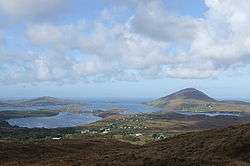Letterfrack
| Letterfrack Leitir Fraic | |
|---|---|
| Village | |
|
View of Letterfrack and Ballinakill harbour, 2008 | |
 Letterfrack Location in Ireland | |
| Coordinates: 53°33′N 9°57′W / 53.55°N 9.95°WCoordinates: 53°33′N 9°57′W / 53.55°N 9.95°W | |
| Country | Ireland |
| Province | Connacht |
| County | County Galway |
| Elevation | 81 m (266 ft) |
| Irish Grid Reference | L697591 |
Letterfrack or Letterfrac (Irish: Leitir Fraic meaning "The Speckled Hill") is a small village in the Connemara area of County Galway, Ireland. It was founded by Quakers in the mid-19th century. The village is just 3 kilometres (two miles) west of Renvyle and 15 kilometres (9 miles) north-east of Clifden on Barnaderg Bay and lies at the head of Ballinakill harbour. Letterfrack contains the visitors centre for Connemara National Park.
Quaker Famine Relief
James and Mary Ellis, a Quaker couple from Bradford in England, moved to Letterfrack, during the Great Famine, Ellis becoming the resident landlord in Letterfrack in 1849.[1] As Quakers the Ellises wanted to help with the post-Famine relief effort. They leased nearly 1,000 acres (405 ha) of rough land and set about reclaiming it, farming it and planting it with woodland.[2] They built a schoolhouse, housing for tradesmen, a shop, a dispensary, and a temperance hotel.[3] In 1857 the property was sold to John Hall, a staunch Protestant and supporter of the Irish Church Mission to Roman Catholics. The ICM used the building with the aim of converting Catholics to Protestantism. After 25 years without much success, Hall sold it in 1882, under the impression he was selling it to a Protestant buyer, for £3000 for 1,000 acres (405 ha).[4]
St Joseph's Industrial School, Letterfrack
Under a false name the Archbishop of Tuam, Dr John McEvilly, bought in 1882 the former Ellis property, which at the time was being used by the Protestant Irish Church Missions to Roman Catholics[5] and established in 1885 St Joseph's Industrial School, Letterfrack[3] which opened in 1887, Letterfrack Industrial School became notorious for neglect and abuse, the school closed in 1974.[6][7]
GMIT Campus
In 1987 the Connemara West began running furniture courses which has become the Furniture College/Campus for the Galway-Mayo Institute of Technology.[8]
Marconi Wireless Station
Letterfrack was selected by Marconi as the location for the transatlantic wireless receiver station for his new duplex transatlantic wireless service. Duplex operation—initially developed by Marconi at Letterfrack—quickly became a standard practice for commercial and military radiotelegraph communication worldwide.
Beginning in 1913, eastbound messages were sent from his Marconi Towers, Nova Scotia high power wireless station to Letterfrack; while westbound messages were sent simultaneously from the Clifden high power wireless station to Louisbourg. The Letterfrack station was closed in April 1917 at the direction of the Admiralty, and was never re-opened for commercial traffic. Some experimental work on shortwave and other work, by Marconi engineers Franklin and Witt, was carried out into the early 1920s.
Media
- Connemara Community Radio broadcasts from Letterfrack.
See also
- List of towns and villages in Ireland
- GMIT, whose Letterfrack campus is the Furniture college.
- Diamond Hill
External links
References
- ↑ Tánaiste Launches Joan Johnson’s book James & Mary Ellis Background and Quaker Famine Relief in Letterfrack Dept. of Trade and Innovation, Monday 31 July 2000
- ↑ James & Mary Ellis Background and Quaker Famine Relief in Letterfrack, by Joan Johnson, Historical Committee of the Society of Friends in Ireland , Dublin 2000.
- 1 2 Living, working and playing in the glow of Diamond Mountain and the shadow of cruelty Irish Times, Wednesday, 18 August 2010.
- ↑ History of Education Letterfrack by Dr. Tony Lyons.
- ↑ Connemara: visions of Chonnacht By Michael Gibbons
- ↑ http://www.paddydoyle.com/a-history-of-neglect/
- ↑ "Report of the Commission to Inquire into Child Abuse, Chapter 8, Letterfrack Industrial School ('Letterfrack'), 1885–1974".
- ↑ College Building - Galway Mayo Institute of Technology GMIT Website
- Whelan D. (ed.) Founded on Fear; Letterfrack Industrial School, war and exile by Peter Tyrrell. Irish Academic Press 2006. ISBN 978-0-7165-3403-7
